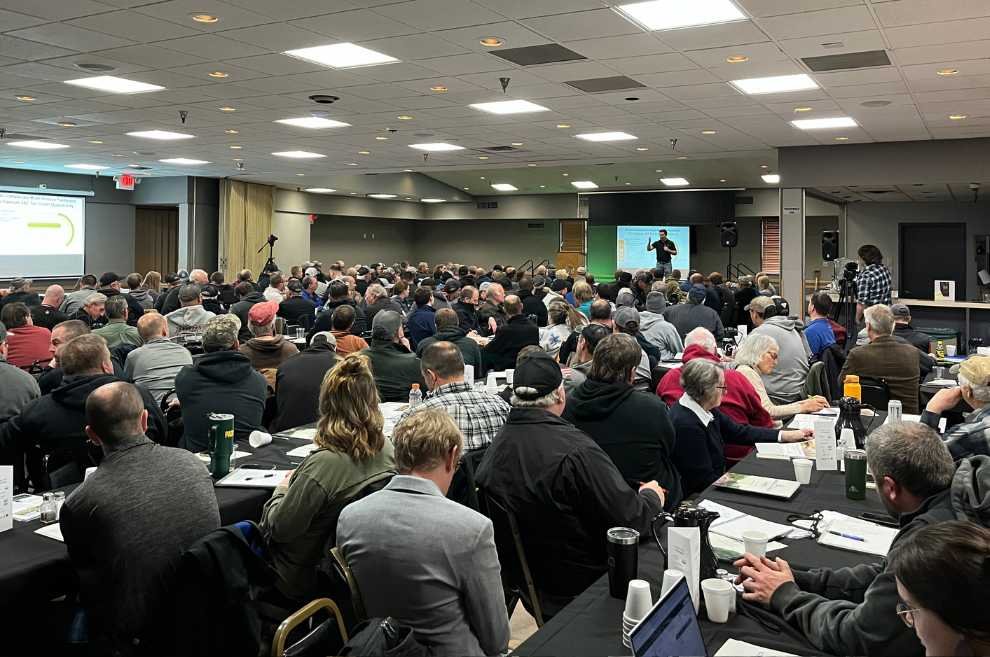Preparing Local Farmers for a Low-Carbon Farming Initiative
It might pique your interest to know what attracted over 250 individuals to a room in Owatonna on a Tuesday afternoon in March. Recently, Clean River Partners and Minnesota Soil Health Coalition, along with many other partners and sponsors, hosted a workshop to educate local farmers about a new low-carbon farming initiative. The workshop was broken up into three major elements - the basics of carbon intensity, selling low-carbon grain for a premium, and improving soil health to increase profits.
Pictured: Mitch Hora, CEO of Continuum Ag, speaking to a room of over 250 individuals about the basics of carbon intensity.
The Basics of Carbon Intensity
Mitch Hora, the CEO of Continuum Ag, initiated the workshop by providing insights into carbon intensity scores, their measurement, and their significance.
Carbon intensity measures the amount of gases, such as carbon dioxide and methane, a company produces during its daily operations. These gases are mainly a result of burning fossil fuels to power machines and engines and can also be released during refining processes that emit certain chemicals into the air. The amount of carbon-based emissions required to produce an item determines its carbon intensity.
You might wonder how this concept relates to agriculture. Farmers have the opportunity to earn incentives by reducing their farm's carbon footprint. To take advantage of this, the first step is to determine your farm's carbon intensity score. A lower score should result in a higher premium for your grains, encouraging more sustainable farming practices.
Continuum Ag is a company that specializes in soil health data intelligence. To help farmers enhance their soil health and increase their profits, the company has created a proprietary platform called TopSoil®. Using this platform is simple - all you need to do is create an account, fill out a profile for your farm, and use the tool to validate the value of your data. At our workshop in Owatonna, the company representatives provided free baseline carbon intensity scores to interested farmers.
Pictured (left to right): Mitch Hora (Moderator and CEO of Continuum Ag), Brian Werner (Executive Director, Minnesota Biofuels Association), Don Burns (Commodity Specialist, Absolute Energy), and Theo Gunther (Climate Smart Origination Manager, ADM).
Selling Low Carbon Grain for a Premium
You have your carbon intensity score; now what? This score is important because it can help you qualify for compensation through the 45Z tax credit, an amendment to the Inflation Reduction Act. According to this amendment, companies that produce low-carbon renewable biofuels, such as ethanol, biodiesel, renewable diesel, and sustainable aviation fuel, can receive tax credits. This is where the ethanol and biofuel industry comes in, and we were fortunate to have four industry professionals at our workshop to discuss it in detail. After the discussion, we had the chance to talk to a couple of panelists one-on-one to gain a better understanding of the topic.
Brian Werner, the Executive Director of the Minnesota Biofuels Association, explained that ethanol produced in Minnesota already contributes to a 50% reduction in greenhouse gas emissions compared to gasoline. He emphasized that the ethanol industry can further reduce its carbon footprint by collaborating with farmers and incorporating climate-smart agricultural practices into the fuel lifecycle. Several questions still need to be addressed, such as U.S. Treasury tax credit guidance and the quantification, monitoring, reporting, and verification of field-level data by farmers and biofuel producers. However, if these details are ironed out, it has the potential to provide numerous environmental and economic benefits to Minnesota.
Don Burns, the Commodity Specialist at Absolute Energy, made some important points about farm profitability. He emphasized that for farms to remain profitable, they need to produce products that are in demand by the consumer. Nowadays, that means fuel, feed, and export products that have a low carbon footprint. Therefore, management decisions at the farm level should be based on two things: return on investment and reducing the product's carbon intensity score to ensure future profitability.
Pictured (left to right): Mark Gutierrez (Moderator and Executive Director of Minnesota Soil Health Coalition), Jerry Ackermann, Peter Kramer, Tim Little, and Tom Cotter.
Improving Soil Health to Increase Profits
To wrap up the discussion, we invited a group of seasoned farmers from the Minnesota Soil Health Coalition to share their thoughts on the "climate-smart" agricultural practices we talked about. It was clear that these farmers were initially driven to adopt these practices due to unsustainable outcomes like erosion, washouts, and flooding. They started small, by implementing cover crops or strip-tilling techniques on small sections of their operations, and gradually expanded their efforts after seeing positive results. It was evident that improving the health of their soil was directly linked to increasing their profits.
During our conversation, the topic of resources for sustainable farming practices came up frequently. These resources weren’t readily available for farmers in the past, and farmers stepped up to fill that void. Many of the panelists are part of the farmer mentor program facilitated by the Minnesota Soil Health Coalition. This program connects farmers who have already implemented sustainable farming practices with those who are interested in learning from them. It's a wonderful example of farmers helping farmers.
The bottom line is that agriculture is about to undergo a significant change, and farmers in the Cannon River Watershed have a chance to be at the forefront of it. To gain a better understanding of soil health practices, carbon intensity scores, and the 45Z tax credit opportunity, farmers can get in touch with Clean River Partners, and we will guide you to the appropriate partner who can provide you with answers to your questions.




